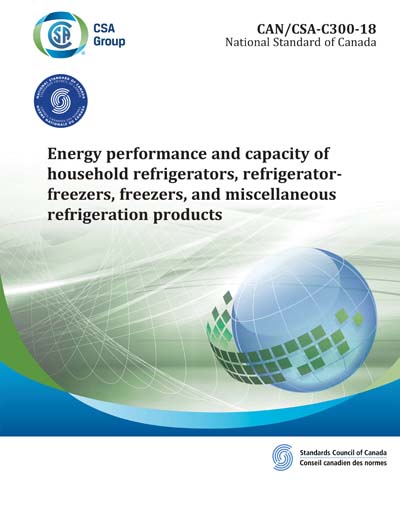Historical
CAN/CSA C300-2018
Energy performance and capacity of household refrigerators, refrigerator- freezers, freezers, and miscellaneous refrigeration products
Preface This is the tenth edition of CAN/CSA-C300, Energy performance and capacity of household refrigerators, refrigerator-freezers, freezers, and miscellaneous refrigeration products. It supersedes the previous editions published in 2015, 2012, 2008, 2000, 1991, 1989, 1984, 1978, and 1977 under the title Energy performance and capacity of household refrigerators, refrigerator-freezers, and freezers and wine chillers. To provide improved clarity to the user, this edition has been re-organized by product section. This Standard is aligned, to the greatest extent possible, with the US Department of Energy (DOE) 10 CFR 430-September 15, 2011, which came into effect in the US on September 15, 2014. The miscellaneous refrigeration products portion of this Standard is aligned to the greatest extent possible, with the US Department of Energy (DOE) 10 CFR 430-June 10, 2016 for miscellaneous refrigeration products, in effect in the US on October 28, 2019. CSA gratefully acknowledges that the development of the CAN/CSA-C300 Standard was made possible, in part, by the financial support of NRCan, BC Hydro, Manitoba Hydro, the Ontario Power Authority (OPA), Efficiency Nova Scotia, Hydro Québec, the Ontario Ministry of Energy, the Canadian Electricity Association (CEA), and Sask Power. Scope 1.1 This Standard applies to compact and household refrigerators, refrigerator-freezers, freezers, and miscellaneous refrigeration products that are electrically operated on a 60 Hz alternating current, with a nominal supply voltage of 115 V. 1.2 This Standard applies to a) refrigerators and refrigerator-freezers (Clause 8) with a maximum capacity of 1105 L (39 ft3); b) freezers (Clause 9) with a maximum capacity of 850 L (30 ft3); and c) miscellaneous refrigeration products (Clause 10). 1.3 The values given in SI (metric) units are the standard. Any values given in parentheses are for information only. 1.4 In this Standard, "shall" is used to express a requirement, i.e., a provision that the user is obliged to satisfy in order to comply with the standard; "should" is used to express a recommendation or that which is advised but not required; and "may" is used to express an option or that which is permissible within the limits of the standard. Notes accompanying clauses do not include requirements or alternative requirements; the purpose of a note accompanying a clause is to separate from the text explanatory or informative material. Notes to tables and figures are considered part of the table or figure and may be written as requirements. Annexes are designated normative (mandatory) or informative (nonmandatory) to define their application.
CSA America, Inc. [csa]

